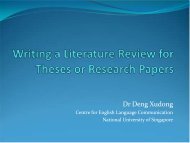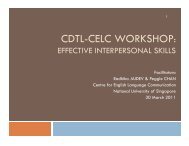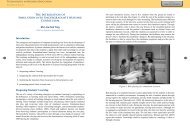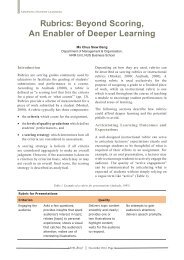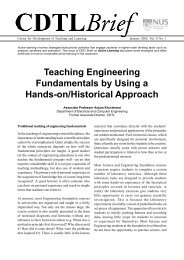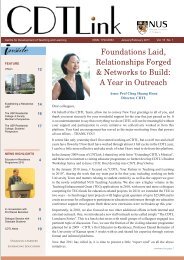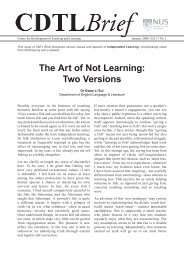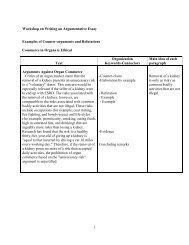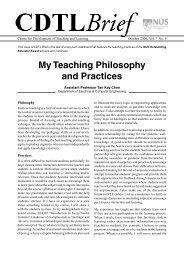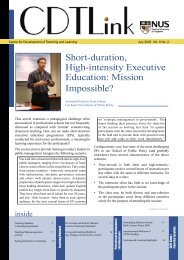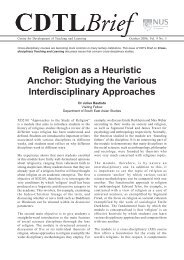Enhancing Nursing Students' Drug Calculation Skills ... - CDTL
Enhancing Nursing Students' Drug Calculation Skills ... - CDTL
Enhancing Nursing Students' Drug Calculation Skills ... - CDTL
You also want an ePaper? Increase the reach of your titles
YUMPU automatically turns print PDFs into web optimized ePapers that Google loves.
On Module Design<br />
<strong>Enhancing</strong> <strong>Nursing</strong> Students’<br />
<strong>Drug</strong> <strong>Calculation</strong> <strong>Skills</strong> Through<br />
Self-directed Learning<br />
Ms Chen Hui-Chen<br />
Alice Lee Centre for <strong>Nursing</strong> Studies<br />
The ability to do self-directed learning<br />
(SDL) is beneficial to nursing students in<br />
developing a lifelong learning habit that<br />
will stand them in good stead in their future<br />
careers. This is because nurses not only have<br />
to acquire medical knowledge throughout their<br />
formal education, they also need to constantly<br />
refresh and update their knowledge even<br />
after they graduate. For example, the correct<br />
methods of doing drug calculation can easily<br />
be forgotten without regular practice. If nurses<br />
are able to regularly refresh their knowledge<br />
of the correct mathematical calculations and<br />
important formulae for drug calculation through<br />
an easily accessible learning interface, medical<br />
errors would less likely occur in hospitals. With<br />
the advent of information technology, online<br />
resources for honing one’s skills in SDL are<br />
widely available. Nevertheless, the habit of<br />
using these resources frequently and effectively<br />
still needs to be cultivated.<br />
Outcomes and Methodology<br />
This project aims to study whether SDL using<br />
online resources can improve our nursing<br />
students’ ability to do drug calculation. A<br />
website which aimed to foster SDL skills was<br />
created for nursing students who took the<br />
module NUR2114 “Medical-Surgical <strong>Nursing</strong><br />
I”. This website (Figure 1) emphasised the drug<br />
calculation component in the module. Students<br />
could access the website at any time and from<br />
any place that they prefer, and they could study<br />
the drug calculations as many times as they<br />
wished.<br />
Figure 1. The main page of the website on drug calculation for NUR2114.<br />
<strong>CDTL</strong> Brief May/June 2013, Page 12
On Module Design<br />
Figure 2. Screen capture of the website’s exercise section.<br />
The website not only facilitated the learning of<br />
the basics of drug calculation, it also included<br />
resources and functions which would enhance<br />
students’ knowledge of this component of<br />
NUR2114. The website’s exercise section (see<br />
Figure 2) allowed students to practice the<br />
calculations they learnt, and the website’s forum<br />
enabled them to post and discuss questions with<br />
their peers. The students could also communicate<br />
with their tutors through emails, in addition to<br />
regular lectures and office hours. Other useful<br />
links to additional learning resources were also<br />
provided in the website.<br />
A pre-test/post-test research design experiment<br />
was used to measure the impact of such an<br />
intervention. The subjects were second year<br />
nursing students who took NUR2114 in the first<br />
semester of Academic Year 2010/2011. A total<br />
of 93 students enrolled for this module. While<br />
all the students had the same rights in accessing<br />
the web resources, participation in this teaching<br />
experiment was voluntary and anonymous.<br />
Among the 81 students who completed the<br />
pre-course assessment and survey in the first<br />
lecture, 80 of them also completed the postcourse<br />
assessment and survey towards the end<br />
of the semester<br />
Data Collection<br />
The assessments and surveys were<br />
administered before and after the practicum to<br />
measure the impact of online SDL. Specifically,<br />
the pre-course drug calculation assessment and<br />
survey were conducted at the very beginning<br />
of the semester before students embarked on<br />
any online SDL activities. This served as the<br />
baseline data. Students took the post-course<br />
drug calculation assessment and survey after<br />
using the website for ten weeks. The two sets of<br />
results were compared and analysed to evaluate<br />
the impact of the intervention on students’ SDL<br />
skills. The SPSS statistical software package<br />
was used to analyse the data collected.<br />
Recommended Citation<br />
Chen H.C. (2013). <strong>Enhancing</strong> nursing students’ drug calculation skills through self-directed learning.<br />
<strong>CDTL</strong> Brief, 16(1), pp. 12-16.<br />
<strong>CDTL</strong> Brief May/June 2013, Page 13
On Module Design<br />
Table 1.Results of the pre- and post-course self-directed learning tests.<br />
Pre-course Self-Directed Learning<br />
Post-course Self- Directed Learning<br />
Mean (SD) 80.75 (2.463) 99.5 (0.303)<br />
Minimun-Maximun 10-100 80-100<br />
Figure 3. Histograms showing the results of the pre- and post-course SDL tests.<br />
<strong>CDTL</strong> Brief May/June 2013, Page 14
On Module Design<br />
Results & Analysis<br />
The pre- and post-course SDL assessments and<br />
surveys were analysed and summarised as<br />
follows:<br />
Profile of students<br />
••<br />
Before doing the SDL activities in the<br />
course, 85% of the participating students<br />
had not learnt about drug calculation, and<br />
only half of these participants had ever<br />
used online resources as a study aid in the<br />
past. Additionally, more than 83% preferred<br />
traditional pedagogies (e.g., lectures,<br />
tutorials, and laboratory sessions) to online<br />
learning.<br />
Improvements in learning<br />
••<br />
The participants experienced a dramatic<br />
improvement in their knowledge of drug<br />
calculation after doing the SDL activities<br />
(See Table 1 and Figure 3). The average<br />
score in the pre-course SDL test was 80.75<br />
(with a standard deviation of 2.46), but<br />
it significantly improved to 99.5 (with a<br />
standard deviation of 0.30) in the postcourse<br />
SDL test.<br />
In addition, the data also indicated the<br />
following:<br />
••<br />
89% of the participants used the online web<br />
resources provided in this project throughout<br />
the experiment.<br />
••<br />
90% of the participants enjoyed the website’s<br />
SDL activities.<br />
••<br />
96% of the participants believed that for<br />
basic drug calculation, the SDL activities<br />
can be good substitutes for traditional<br />
pedagogies.<br />
• • 96% of the participants agreed that after<br />
this project, they were more confident about<br />
doing drug calculations during their hospital<br />
attachments.<br />
The participants also shared their experiences<br />
regarding the use SDL as a teaching method.<br />
Some of the representative comments we<br />
garnered were as follows.<br />
The topic is suitable for SDL activities<br />
On whether drug calculation is a subject that is<br />
suitable to be learnt through SDL activities:<br />
○ ○ “<strong>Drug</strong> calculation can be learnt easily<br />
through self-directed learning.”<br />
○ ○ “It’s a very easy topic so do not need a<br />
lecture on it. Self-learning is sufficient.”<br />
○ ○ “Basic [d]rug [c]alculation is easily<br />
learnt and is simple math. Therefore it<br />
can be a self-directed learning.”<br />
○ ○ “No need to waste time we can learn<br />
ourselves.”<br />
Sufficient foundation knowledge in<br />
mathematics facilitates SDL<br />
On whether students have sufficient knowledge<br />
in mathematics to conduct SDL:<br />
○ ○ “Basic drug calculation is easy to learn<br />
by self-directed learning as we have<br />
already have the foundation for basic<br />
math and thus easy to learn and do the<br />
calculations.”<br />
SDL makes it less stressful<br />
On whether SDL for drug calculation is less<br />
stressful than learning the same knowledge in<br />
a class:<br />
○ ○ “I find it better to learn without stress<br />
[and] at my own.”<br />
SDL offers flexibility in learning<br />
On whether the SDL approach was more<br />
flexible for learning drug calculation, students<br />
can study the materials at their preferred pace:<br />
○ ○ “Self-directed learning is suitable for<br />
calculation as different people require<br />
different pace to comprehending time.<br />
Able to understand more.”<br />
○ ○ “Different people have different ways of<br />
understanding formula/concepts during<br />
calculation.”<br />
<strong>CDTL</strong> Brief May/June 2013, Page 15
On Module Design<br />
Immediate feedback provided<br />
On whether the SDL interface provided<br />
immediate feedback to the students:<br />
○ ○ “[The] [o]nline quiz was helpful as it<br />
provides information and we can get back<br />
the results immediately. In this way, we<br />
can learn from our mistakes.”<br />
Sufficient resources in the SDL interface<br />
On whether the SDL interface provided<br />
adequate resources:<br />
○ ○ “The online resource and materials had<br />
sufficient information to learn.”<br />
Other positive comments from students<br />
included the following:<br />
○ ○ “Helps us to understand better”<br />
○ ○ “Self-directed learning is awesome.”<br />
○ ○ “Self-direction leads to have discovery.”<br />
○ ○ “We will remember more if selfdirected.”<br />
Concluding Remarks<br />
In conclusion, current knowledge about drug<br />
calculation is essential for nurses to reduce<br />
their risk of committing medication errors and<br />
enhancing patient safety. In this regard, nurses<br />
need to keep maintaining and updating their<br />
knowledge of drug calculation. In this teaching<br />
experiment, we introduced an SDL interface<br />
with online resources to our nursing students,<br />
and the impact of this learning method was<br />
evaluated. A comparison between the precourse<br />
and post-course assessments and surveys<br />
suggested that the learning method using SDL<br />
interface enhances our students’ learning<br />
experience. They felt that the SDL interface was<br />
a suitable tool for learning drug calculation.<br />
Overall, the teaching practicum was successful.<br />
Colleagues from other disciplines can consider<br />
incorporating such an online learning interface<br />
to cultivate SDL skills in their modules in the<br />
future to test its general applicability.<br />
References<br />
Ashby D.A., (1997). Medication calculation skills of<br />
the medical-surgical nurse. MEDSURG <strong>Nursing</strong>, 6(2),<br />
pp. 90-4.<br />
Gillham D., & Chu S. (1995). An analysis of student<br />
nurses’ medication calculation errors. Contemporary<br />
Nurses, 4(2), pp. 61-64.<br />
Grandell-Niemi H, Hupli M, Leino-Kilpi H, & Puukka<br />
P (2003). Medication calculation skills of nurses in<br />
Finland. Journal of Clinical <strong>Nursing</strong>, 12(4), pp. 519-28.<br />
Wright K., (2010). Do calculation errors by nurses<br />
cause medication errors in clinical practice? A<br />
literature review. Nurse Education Today, 30(1), pp.<br />
85-97.<br />
Wright K, (2008) Can effective teaching and learning<br />
strategies help student nurses to retain drug<br />
calculation skills? Nurse Education Today, 28 (7),<br />
pp. 856-64.<br />
A bout the Author<br />
Ms Chen Hui-Chen teaches NUR2114 and NUR2116 “Medical-<br />
Surgical <strong>Nursing</strong> I& II”. She believes that future healthcare<br />
providers should be encouraged to enhance their clinical knowledge<br />
and skills with a self-directed learning (SDL) approach in order to<br />
promote self-management and self-monitoring as well as stimulate<br />
motivation.<br />
<strong>CDTL</strong> Brief May/June 2013, Page 16



